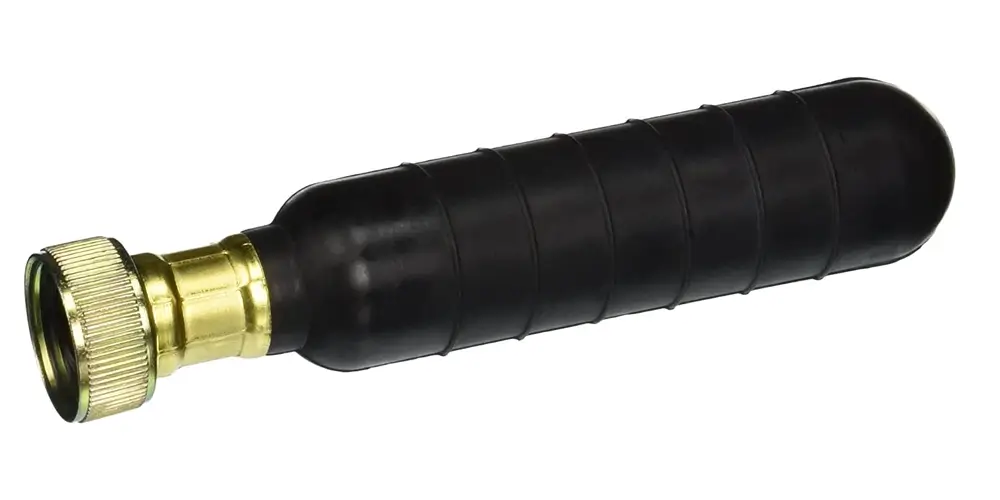The Little Bladder That Could
A plunger is the go-to DIY tool for minor drain clogs. Every home should have two — a cup plunger for sinks and a flange plunger for toilets.
Some homeowners keep a snake in the garage for tougher jobs, or a stash of plastic clog removers for bathroom drains blocked by hair and soap residue.
But do they have a drain cleaning bladder on hand? Or even know what it is?
What’s a Drain Cleaning Bladder & How Does It Work?
A drain bladder, or blow bag, is a heavy rubber balloon that attaches to a standard garden hose. It works like a miniature hydro jet with a high-pressure water stream to clear clogs and debris.
- You connect one end of the hose to a faucet or fixture and screw the bladder onto the opposite end.
- You insert the bladder into a clogged drain and push the hose through.
- You slowly turn on the water (or get someone else to do it if the drain is far from the faucet).
- Water pressure expands the bladder to the walls of the pipe.
- Pressure increases until the bladder shoots a high-pressure water jet to clear the blockage.
Drain bladders come in different sizes and weights for different diameters of piping.
When in doubt, it’s best to err on the large size so that you don’t damage your pipes with a too-small or heavy bladder.
Please exercise caution! Orange Coast Plumbing has witnessed far too many blown pipes due to inexpert DIY drain bladder “repairs.”
Drain Bladder vs. Snake
A snake is a long, flexible cable that reaches down pipes to clear tough clogs.
It works like a drill, rotating a corkscrew spring to punch a hole through sludge. But it can leave residual gunk on drain walls.
A drain bladder is more like a hydro jet and is an excellent follow-up option, scouring anything the snake misses. And you can re-snake the drain for a super-duper clean after the blow bag procedure. That’ll teach the sludge not to stick around in your plumbing!
Which is better? Both can clear stubborn clogs but go about it in different ways.
- Start with a snake, which is safer and less likely to break corroded pipes.
- Follow up with a drain bladder to clear the drain completely. But if you don’t have a snake, a drain bladder can clear a clog from start to finish.
Can a Drain Bladder Break a Pipe?
Yes, a drain bladder can break or damage pipes in several ways.
- An incorrectly sized bladder can overexpand and burst the pipe.
- Too much water pressure can increase the jet stream’s force to the point where it breaks old, corroded pipes.
- Blockages in the garden hose can strain your plumbing system.
- If the bladder gets lodged in a line, you may have to call a plumber to remove it. That could be expensive!
Always use a correctly sized drain bladder. Be careful with water pressure, increasing it only when lower pressure fails to clear the clog.
A drain bladder should be the last resort, not your first option. And the best option for stubborn clogs is to call a plumber.
What to Know Before You Begin
1. A drain bladder will work only under certain conditions.
A drain bladder may not clear large clogs. Also, it needs sufficient water pressure to work.
It may not be effective if:
- Your home has low water pressure.
- The bladder is the wrong size. It has to expand to the circumference of the pipe to create a tight seal, or water will escape behind it, and there won’t be enough pressure to remove the clog.
- There’s insufficient pressure in the pipe. Vent lines and unclogged pipe connections between the bladder and the clog will allow water to escape and prevent pressure buildup.
Whenever possible, insert the bladder into a clean-out fitting with direct access to your main sewer line.
2. A bladder can burst if you’re not careful.
A drain cleaning bladder has a maximum safe water pressure point. Filled past this point, it can burst and take out a section of your pipe.
- Know the pressure specifications of the bladder.
- Be aware of the water pressure inside your building.
- A water pressure regulator attached to your plumbing system can reduce high water pressure to acceptable levels.
3. A drain bladder can cause injuries.
Again, this concerns water pressure and the bladder’s safe operating limits.
But if a bladder bursts, debris could fly out the drain, potentially injuring you.
- Always wear eye protection and protective clothing.
- Stand to one side of the drain, not over it.
- Fill the bladder slowly and always stay within its limits.
4. A bladder can damage your drain lines.
Sometimes the clog is stronger than the bladder. If the clog proves as immovable as Stonehenge, built-up pressure in the pipe has to go somewhere. That “somewhere” may be the joints of your drain line, especially if those joints are already weak. Or pressure could burst the pipe.
And if water doesn’t force its way through drain line joints, it may shoot back up the line toward you (another reason to stand clear of the drain opening).
How to Use Your Newly Purchased Drain Bladder
Please follow the steps we outline here. No shortcuts! We want you to be safe!
1. Set up the drain bladder.
- Attach a garden hose to a cold-water fitting. It can be a faucet or a kitchen or bathroom fixture; for fixtures, you may need an adapter.
- Screw the drain-cleaning bladder onto the other end of the hose.
- Insert the bladder into the clean-out fitting or drain opening.
- At a minimum, it should sit six inches from its insertion point. The further you can push it down the line, the better.
2. Turn on the water slo-o-o-wly.
- Stand back from the drain opening and gradually turn on the water to the hose.
- If the water source is far from the drain, recruit someone to help.
- DO NOT open the tap in full force from the very beginning. Start slowly; build pressure gradually.
- The bladder will fill on its own. When it reaches capacity, a pressure-sensitive valve will open and release a pressurized jet of water down the drain toward the clog.
- If all goes well, the clog will clear. Let the water from the hose run for several minutes to clean any remaining gunk and debris.
3. Check the results.
- The bladder will deflate when your turn off the water.
- Pull it from the drain opening and check the results.
- If you see standing water in the drain, our hard-working bladder friend has failed to clear the blockage. It’s time to call a plumber.
- Otherwise, the bladder has worked as intended. You now have a clear drain line.
Can You Reuse a Drain Bladder?
Yes, you can use a bladder any number of times as long as it’s undamaged, the rubber is in good condition, and you follow the guidelines outlined here.
But the most persistent clogs are beyond the reach of DIY repair, requiring the expertise and tools of a plumber or even a pipe replacement.
Call us for an honest assessment. We’ll diagnose the problem fast and fix it affordably.
FAQs: Using a Drain Bladder
Q: Can I use a drain bladder in outdoor drains like yard or gutter pipes?
Yes, but ensure the bladder and hose are suitable for outdoor use and that the hose connection to the drain is secure. Outdoor drains may accumulate debris like leaves that require manual removal before using the bladder.
Q: What should I do if the bladder gets stuck in the pipe?
Don’t apply additional water pressure. Turn off the water supply immediately to stop further expansion, then gently pull on the garden hose to retrieve the bladder. If it remains stuck, call a plumber to avoid additional damage to the pipe.
Q: Is it safe to use a drain bladder with hot water?
No, the high temperature can weaken the rubber and lead to damage or bursting. Only use cold water to ensure the bladder’s durability and safety.
Q: Can I use a drain bladder in pipes made of materials other than metal?
Yes, with caution. Old or brittle PVC or plastic pipes are at greater risk of damage. Always check the condition of your pipes and use the bladder at the appropriate pressure for the pipe material.
Q: How can I prevent drainage problems that require a drain bladder?
Regularly clean your drains using safe household solutions, such as baking soda and vinegar, or install sink strainers to catch debris. Avoid pouring grease, oils, or non-dissolvable materials down your drains, and schedule annual professional inspections if your plumbing is prone to issues.
Q: Are there any situations in which a drain bladder shouldn’t be used?
Avoid using a drain bladder if you suspect a pipe has pre-existing damage, such as cracks or leaks. Also, don’t use it in frozen pipes. Ice blockages require specialized methods for removal.
Q: What size drain bladder works best for household use?
Most household drains require small to medium-sized drain bladders, which typically work for pipes ranging from 1 to 4 inches in diameter. Always measure your pipe size and choose the appropriate bladder to ensure proper sealing and functionality.
Q: Can a drain bladder resolve recurring drain clogs?
Not entirely. While it may clear the immediate blockage, recurring clogs usually indicate deeper issues, such as root intrusion or damaged sewer lines. For recurring problems, consult a professional plumber.


